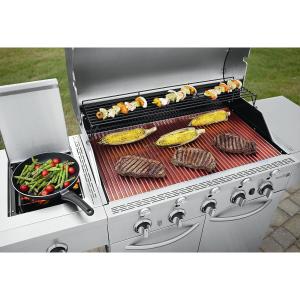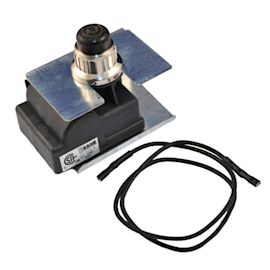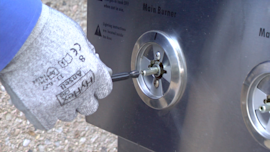Easy DIY gas grill repairs if the burner won't light


So what do you do when you've planned for the big backyard BBQ for weeks just to discover the burners on your gas grill won't light? The neighbors are all coming, and the office crowd—even the in-laws will be there. You've decided on the menu and bought all the food. Don't panic! You might be able to figure out the problem, get your part from Sears PartsDirect and fix it yourself.
Our DIY gas grill repair section has troubleshooting tips and common questions that can help you find the problem, and our easy-to-follow repair guides make fixing the problem a snap.
Start with the obvious
Make sure the propane tank has gas in it. This video shows you how. Once you confirm you have plenty of propane, check the regulator hose and tank for signs of a leak. Turn off the gas if you find a leak, and replace the tank or the hose if needed; the hose is usually available as part of the pressure regulator.
Test the gas grill burners
If the tank and hose are fine, narrow down the problem a bit more. It could be the gas flow or ignition, or a clogged or damaged burner.
The easiest thing to test is gas flow. To see if the burners are getting gas, turn on the burner and carefully try to light them manually with a long-handled lighter or match.
If none of the burners light, the most likely cause is a lack of gas flowing through the pressure regulator. If the burners all ignite manually, gas flow is good and the problem is most likely with the igniter electrode. If some but not all burners ignite when you light them manually, the problem could be a damaged or clogged burner, the igniter electrode or the manifold.
Here's more about those repairs.
The repairs
Gas grill pressure regulator
The pressure regulator controls the gas pressure from the propane tank to the grill. Reset the regulator following the instructions in your owner's manual. If the regulator doesn’t allow gas to flow after resetting it, replace it. For instructions, see our DIY repair guide, How to replace a gas grill pressure regulator.
Gas grill igniter electrode
The igniter electrode produces a spark that ignites the gas in the burner. Check the alignment of the igniter and make any adjustments needed. Check the electrode for any buildup of food spills, carbon or other debris, and clean the electrode if needed. Some ignition systems use a battery; check for a weak battery and replace it if necessary.
If the igniter still doesn't produce a spark, or if you find damage to the electrode, replace the igniter electrode by following the instructions in our DIY repair guide How to replace a gas grill igniter electrode.
Clogged or damaged gas grill burner
The burner distributes the propane gas that creates the flame once ignited. Damage to the burner or a clog will prevent it from lighting. Remove the burner grates and flavor bars, and inspect inside the burner tubes and burner ports for clogs such as spider webs or food spills. Clean the burners and ports with a bottle brush or stiff wire as needed.
If you find rust or damage to the burner, you can replace it easily by following the instructions found in our DIY repair guide How to replace a gas grill burner.
Damaged gas grill ignition module
The ignition module sends current to the igniter electrode that arcs to light the gas. If the igniter electrode won't spark, first check the ignition module battery and replace it if it's dead.
If the ignition module still doesn't send current to the igniter electrode, replace the ignition module using the instructions in our DIY repair guide How to replace a gas grill ignition module.
Symptoms for gas grills
Choose a symptom to see related gas grill repairs.
Main causes: nearly empty fuel tank, faulty pressure regulator, burner tube clogs, bad burner tube alignment to gas valv…
Main causes: empty fuel tank, tripped flow-limiting device on the pressure regulator, faulty manifold valves, burner tub…
Main cause: worn wheel…
Main causes: damaged or dirty flame tamers, corroded firebox, accumulated grease and debris in the grease pan…
Main causes: clogged burner tubes, cracked insulators on igniter electrodes, wiring failures, bad ignition module, manif…
Repair guides for gas grills
These step-by-step repair guides will help you safely fix what’s broken on your gas grill.

How to replace a gas grill wheel
Replace a broken or damaged wheel in less than 15 minutes.…

How to replace a gas grill igniter electrode
Replace the igniter electrode on your gas grill if it won’t light the burner.…

How to replace a gas grill ignition module
Follow these steps to replace the ignition module if it doesn't produce a spark. …
Articles and videos for gas grills
Use the advice and tips in these articles and videos to get the most out of your gas grill.

Learn about all the convenient features on our Sears PartsDirect website that make your parts purchases easier.…

Get answers to frequently asked questions about Sears and Sears PartsDirect.…

A conversion kit and a few simple tools are all you need.…